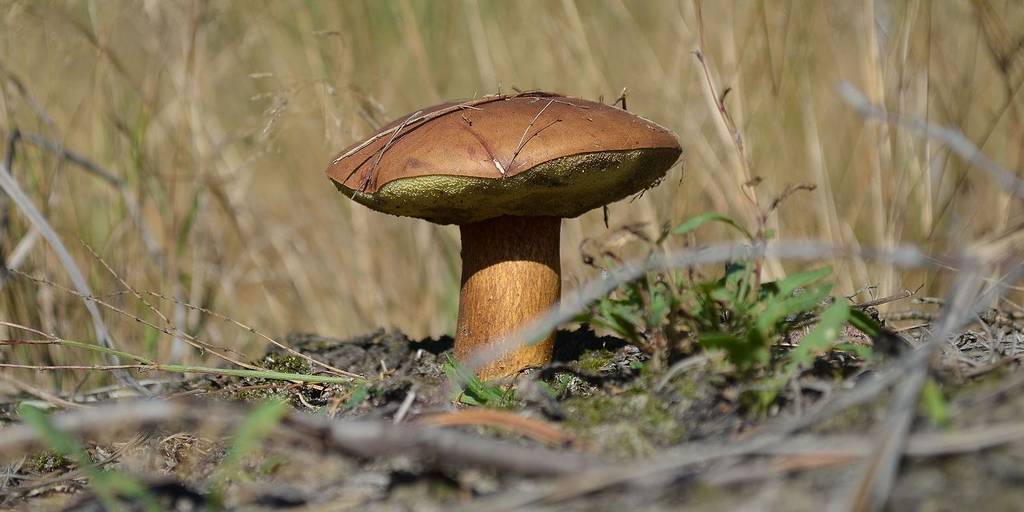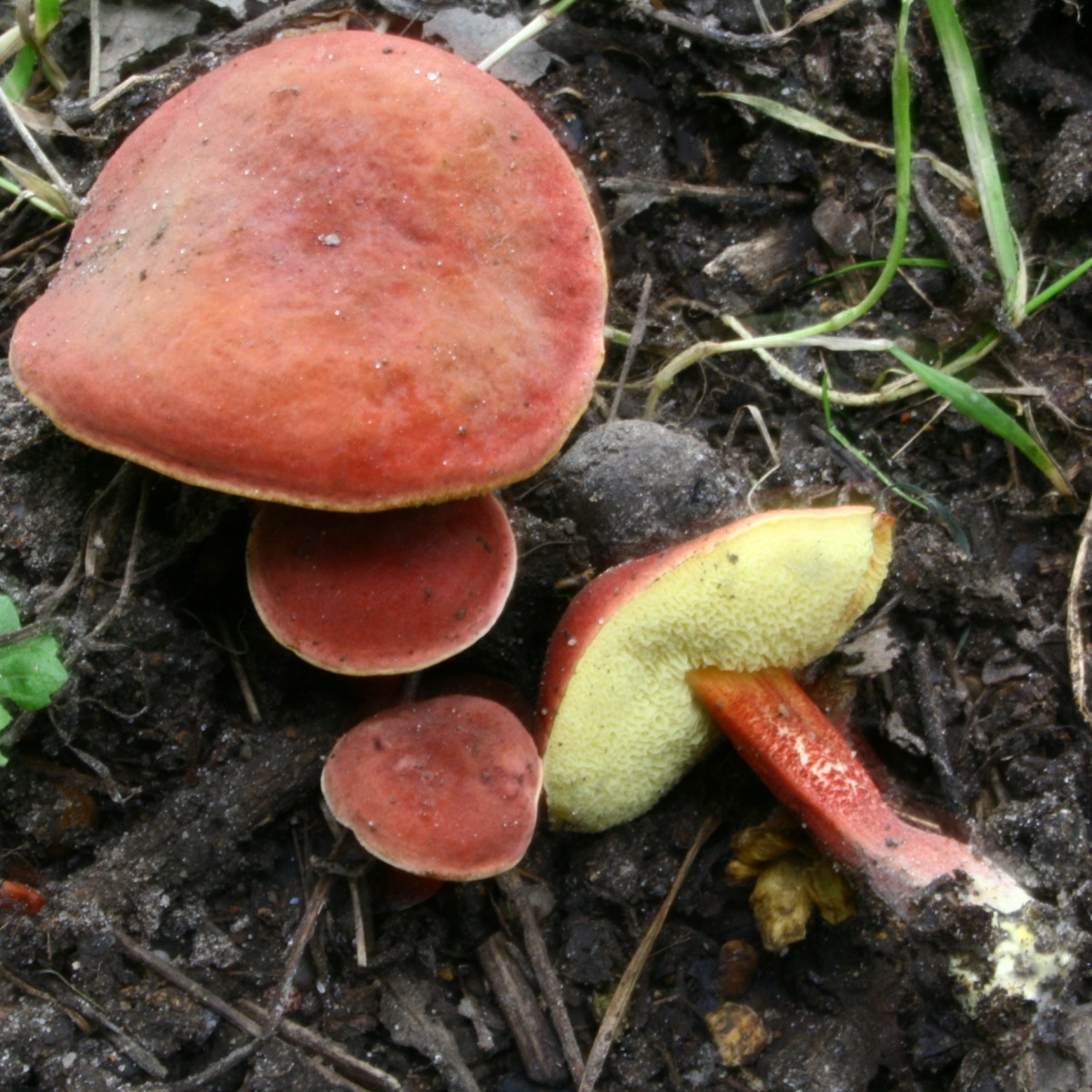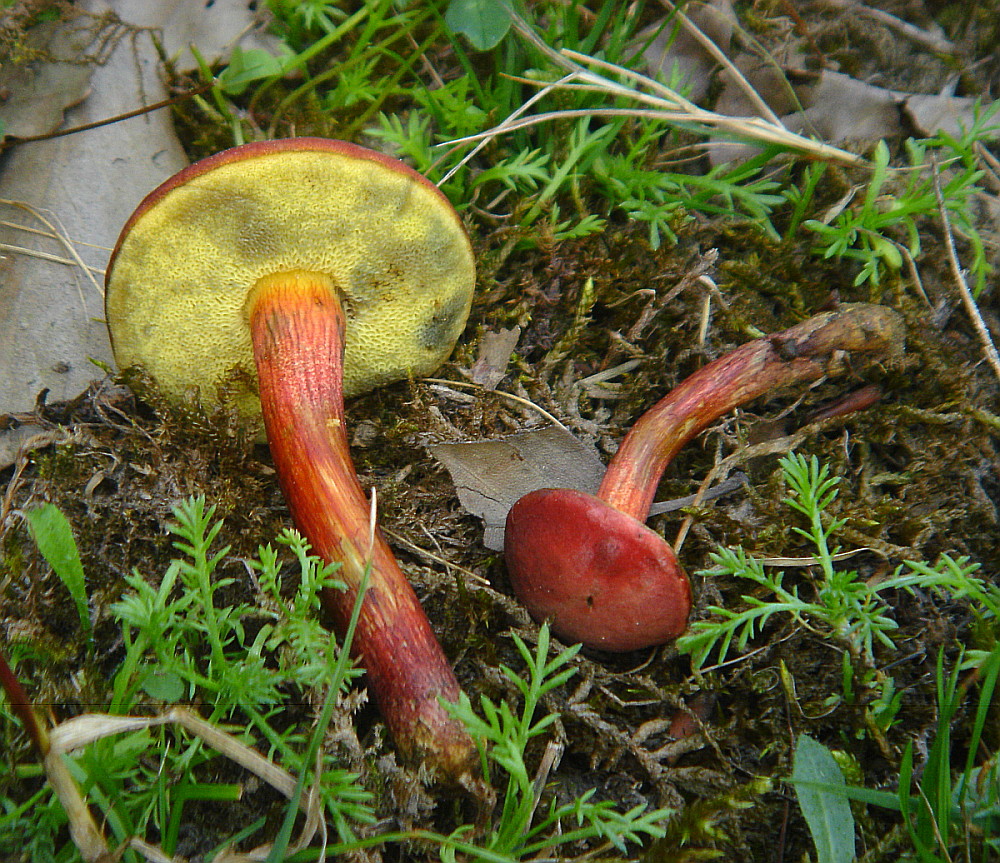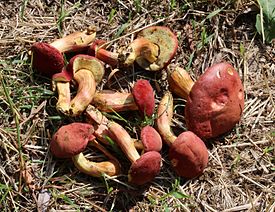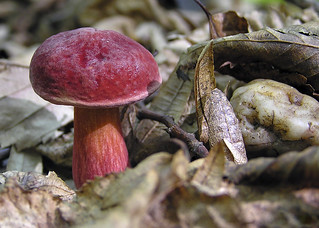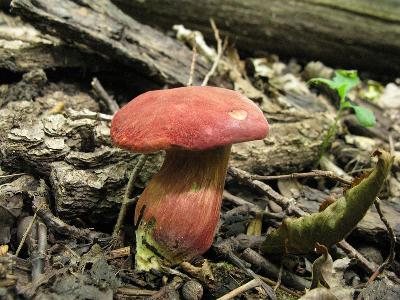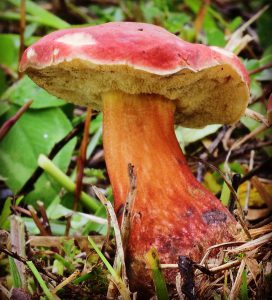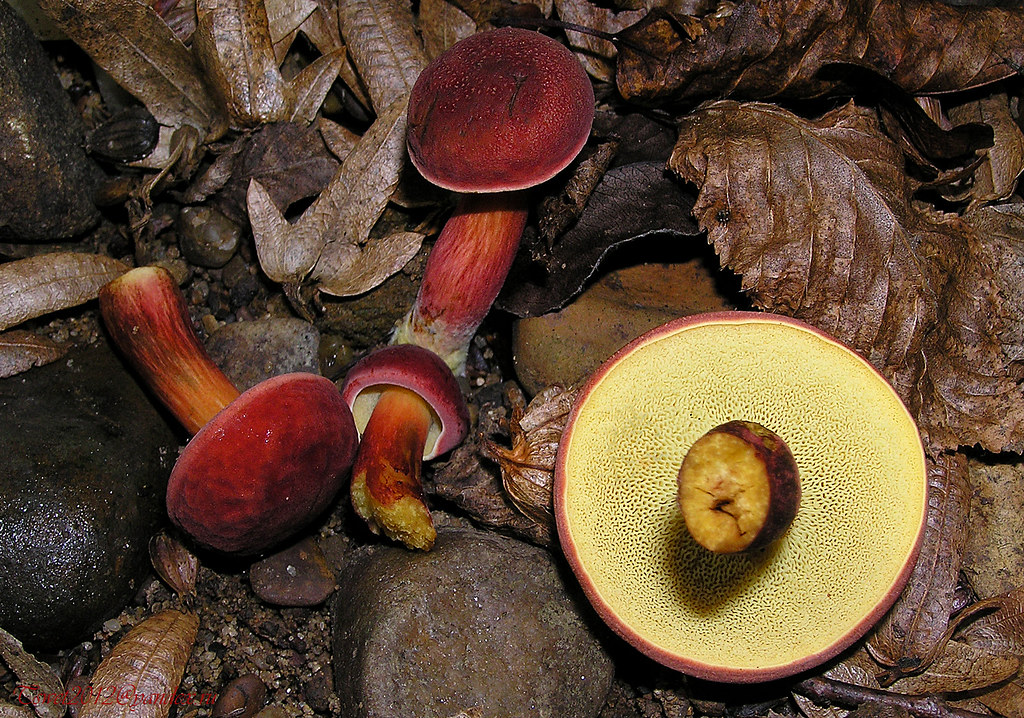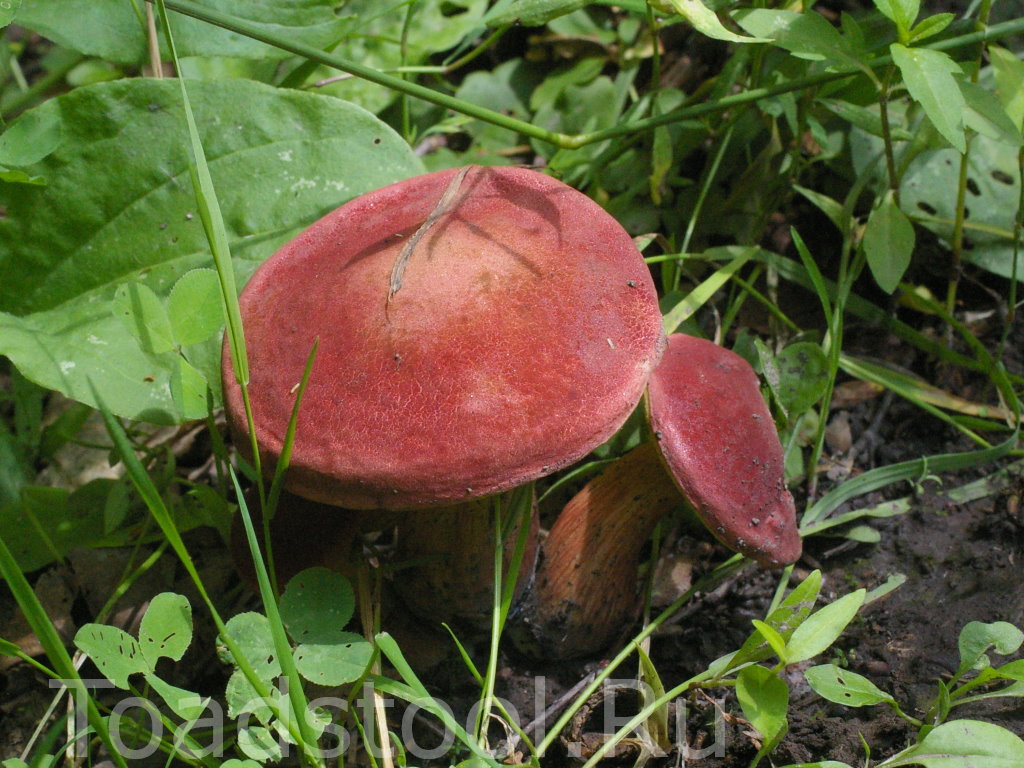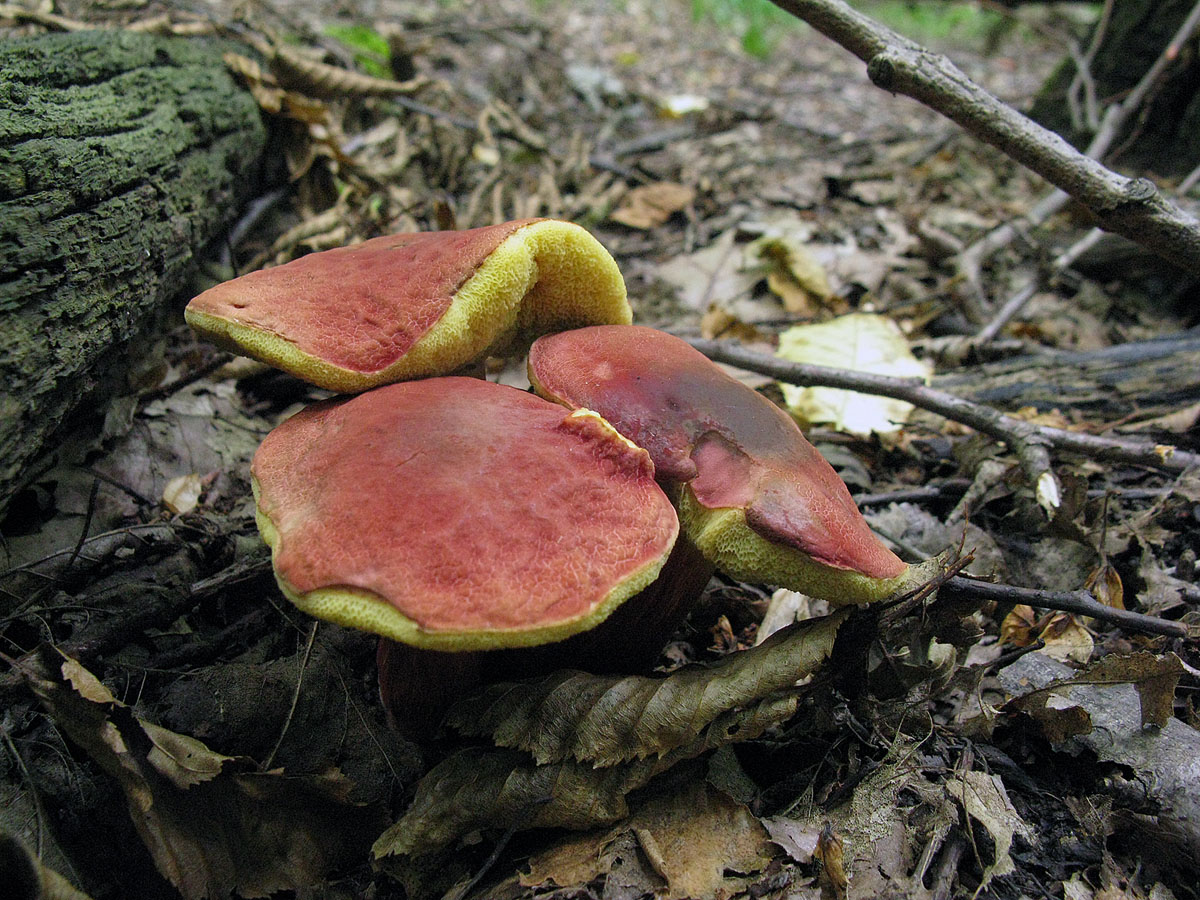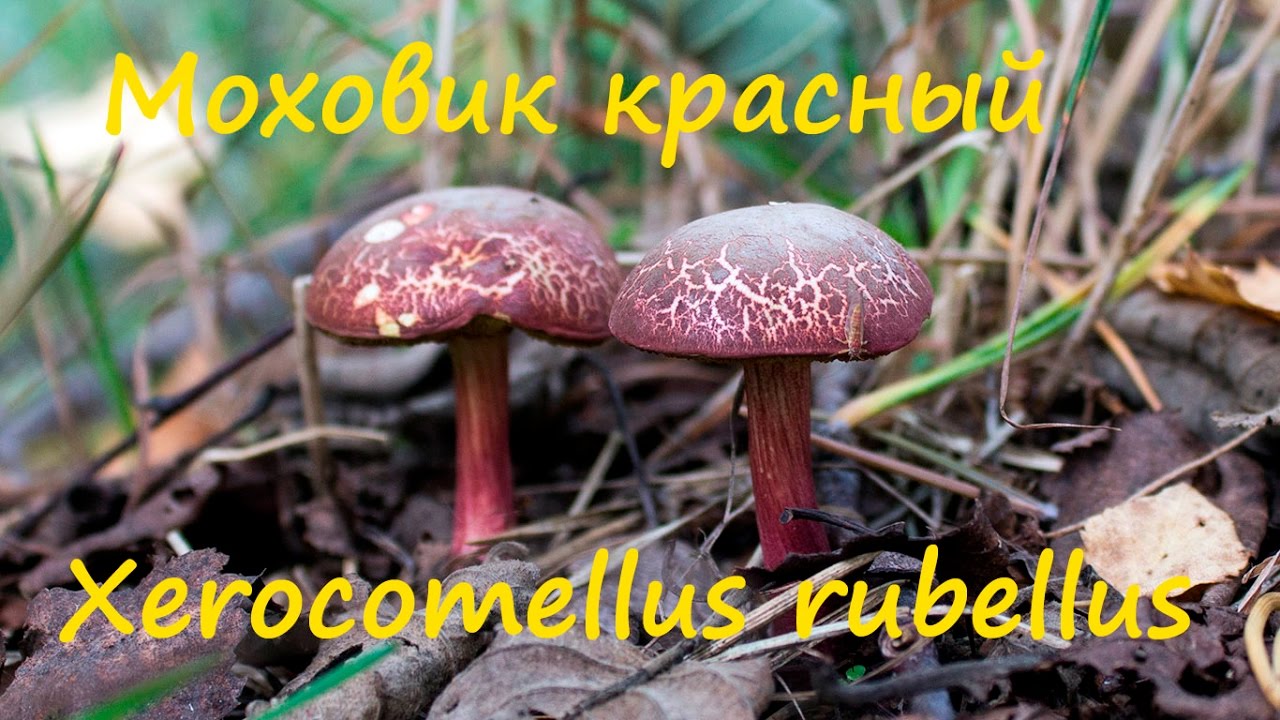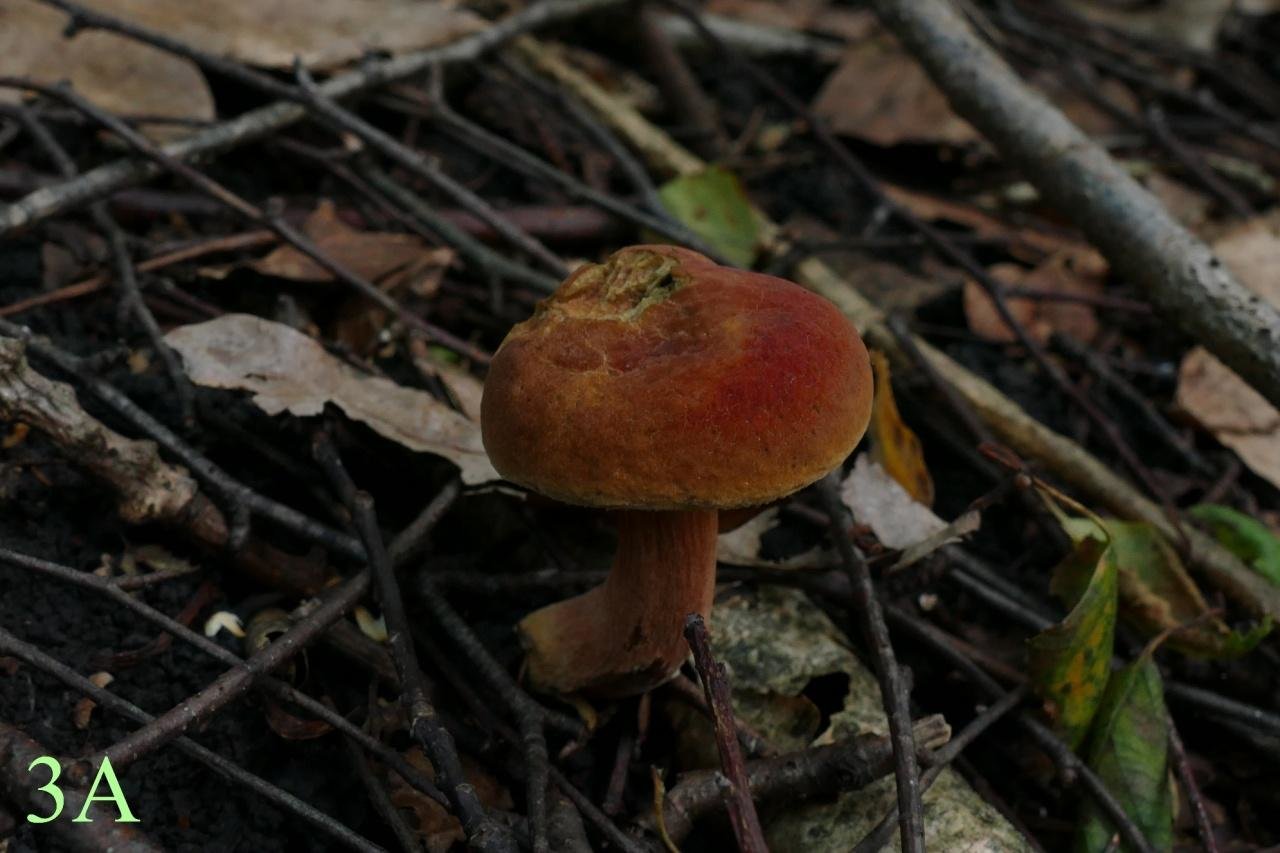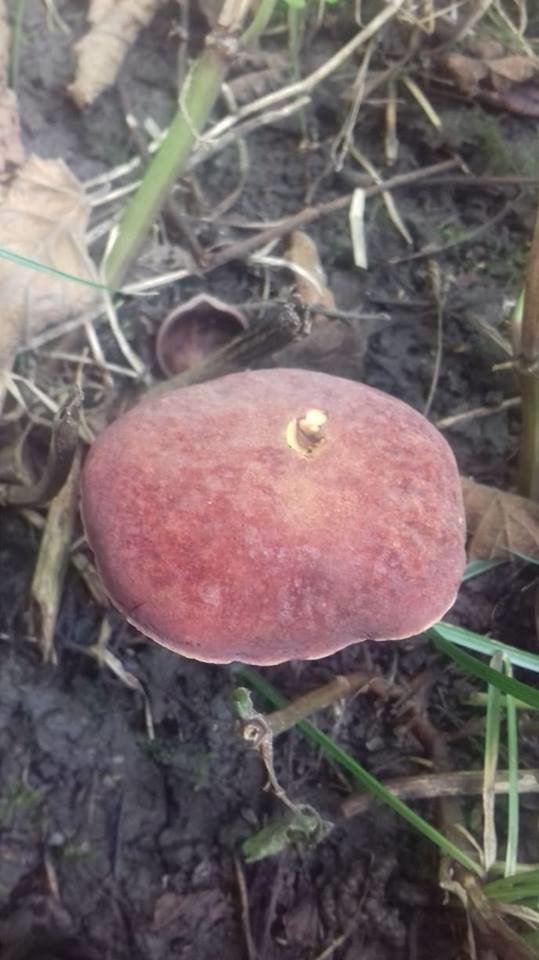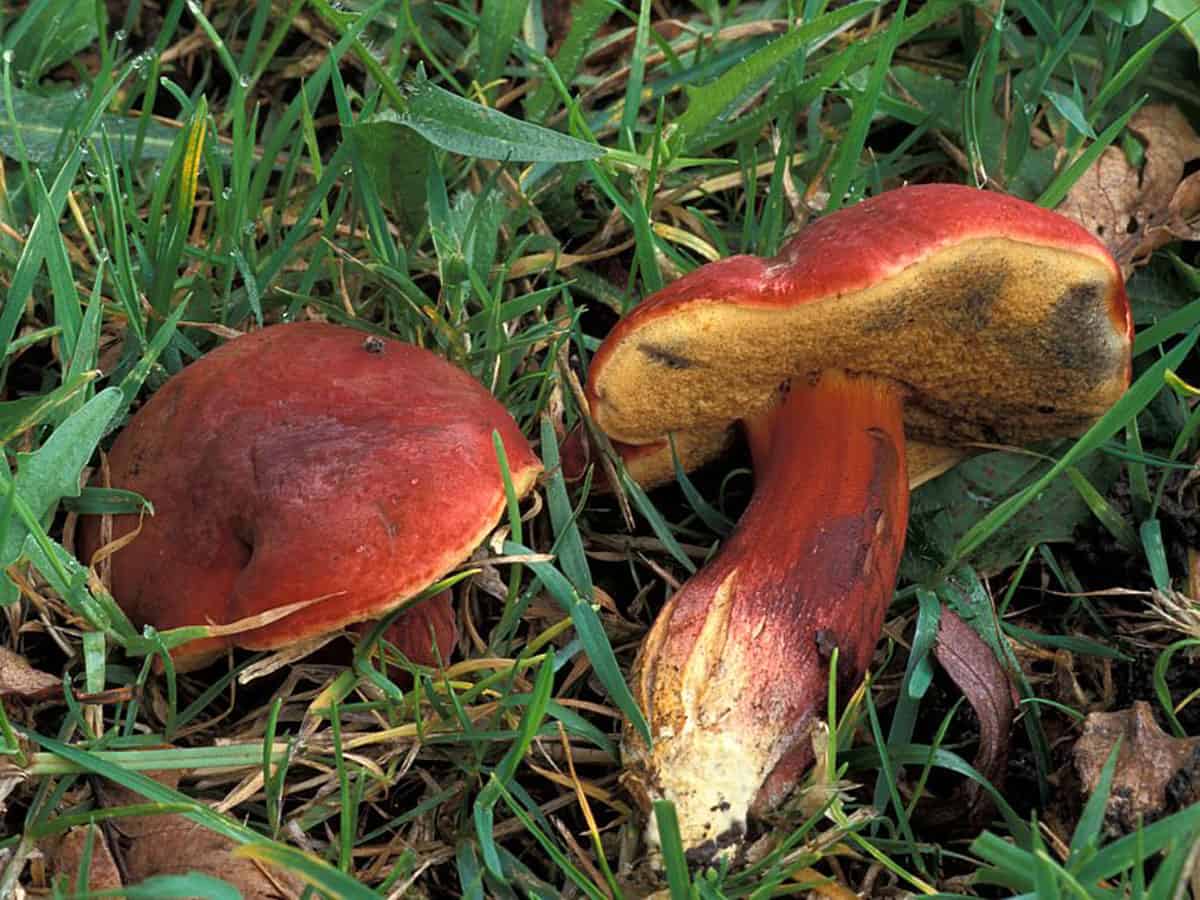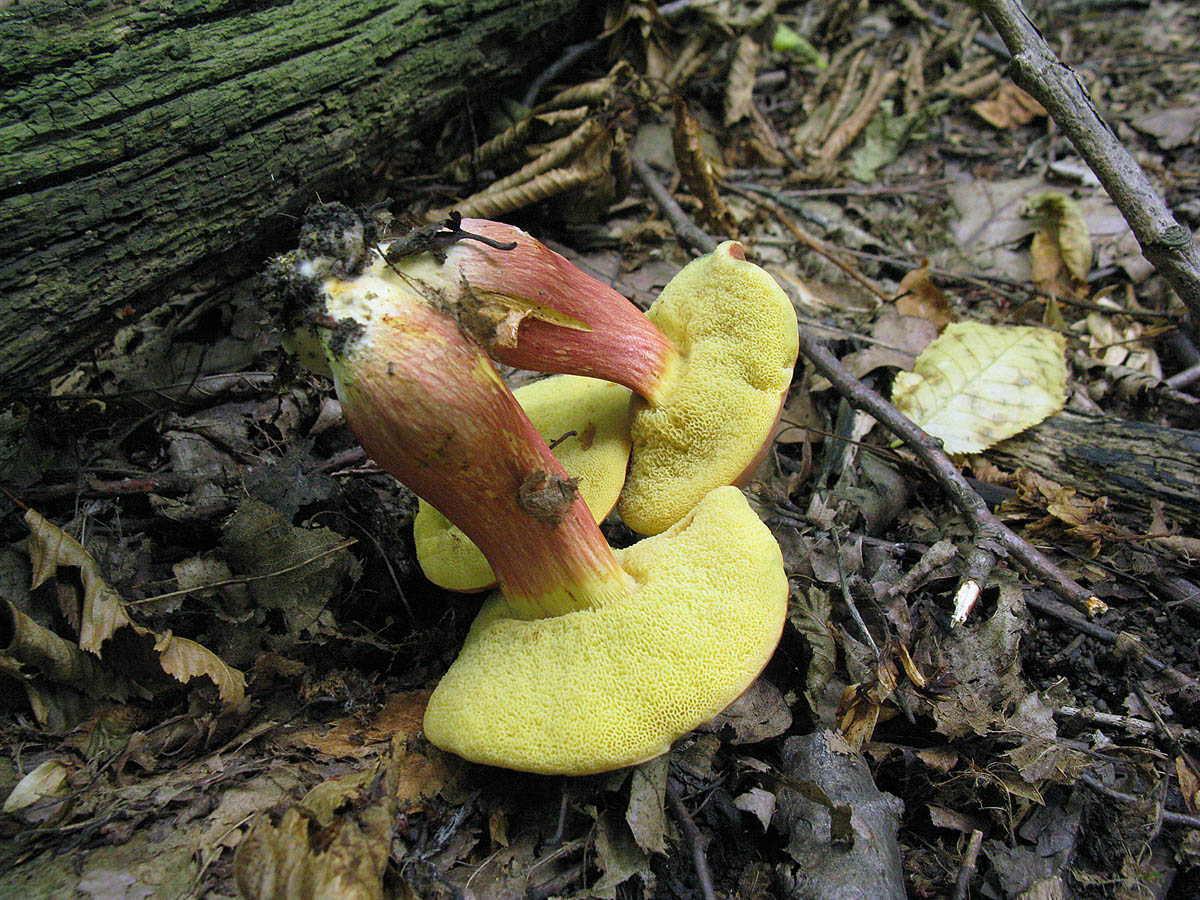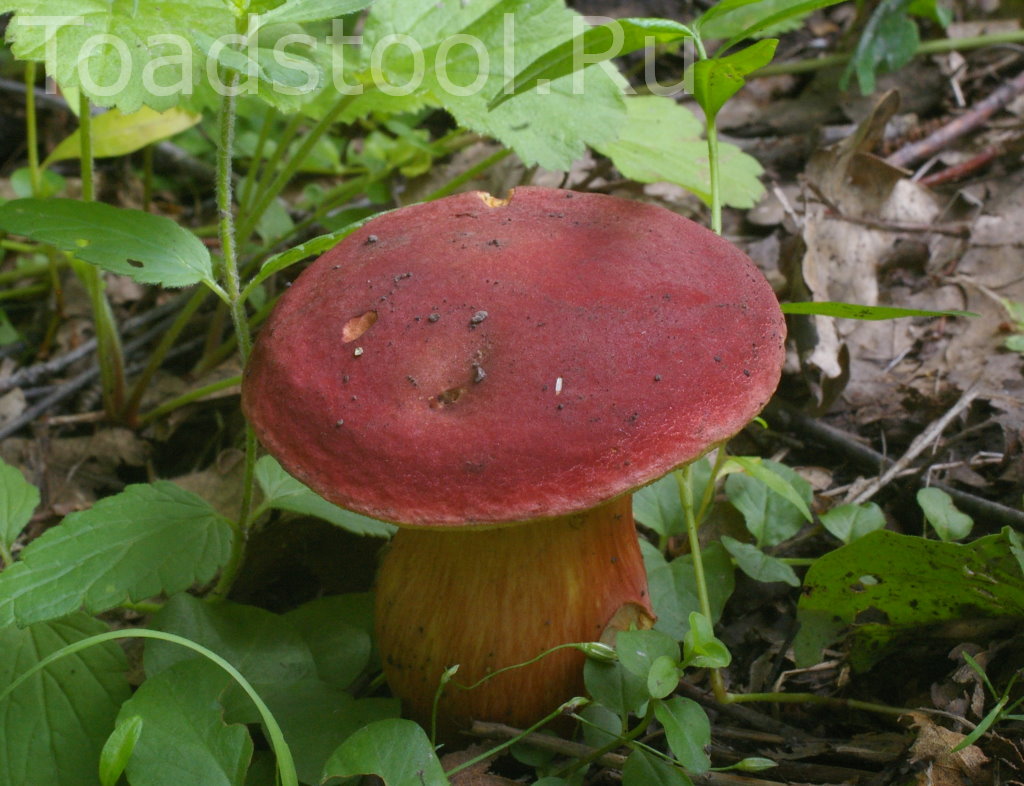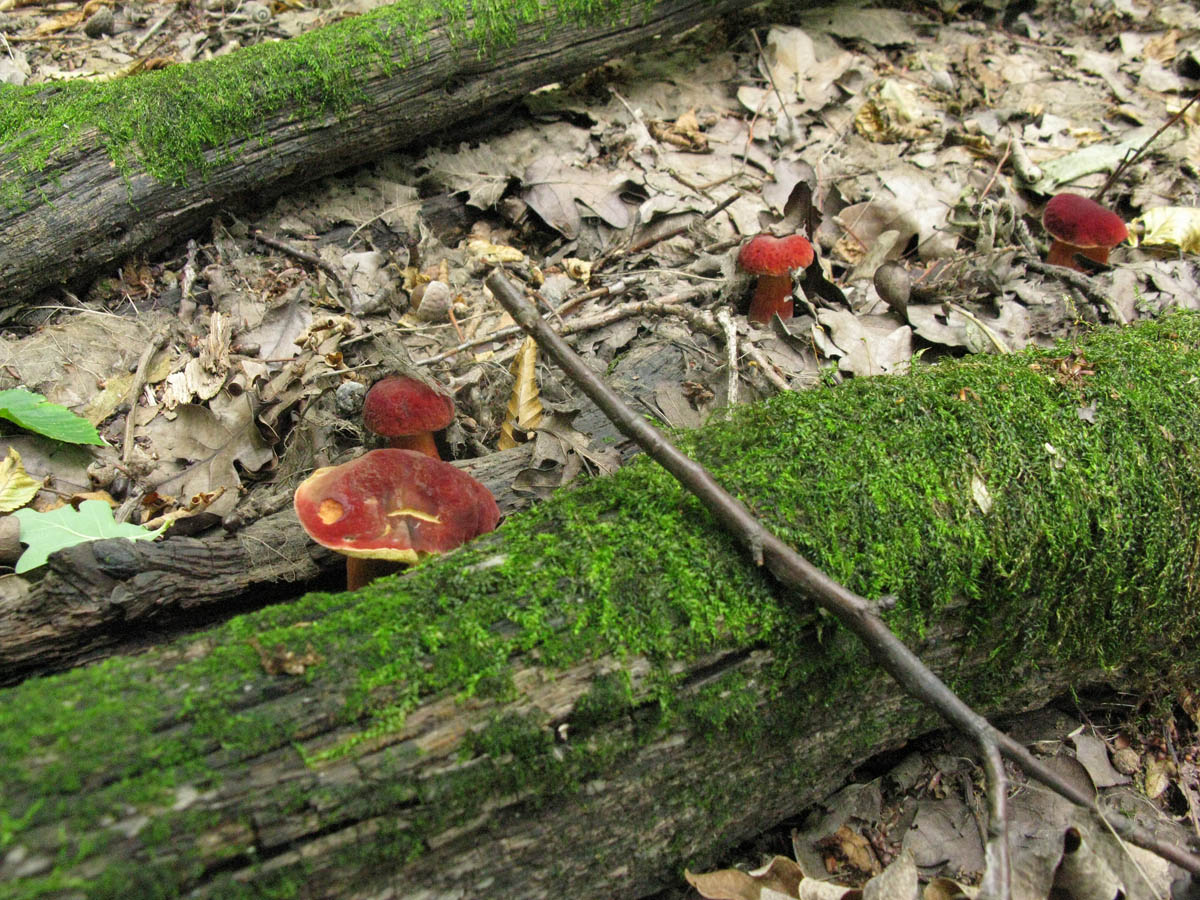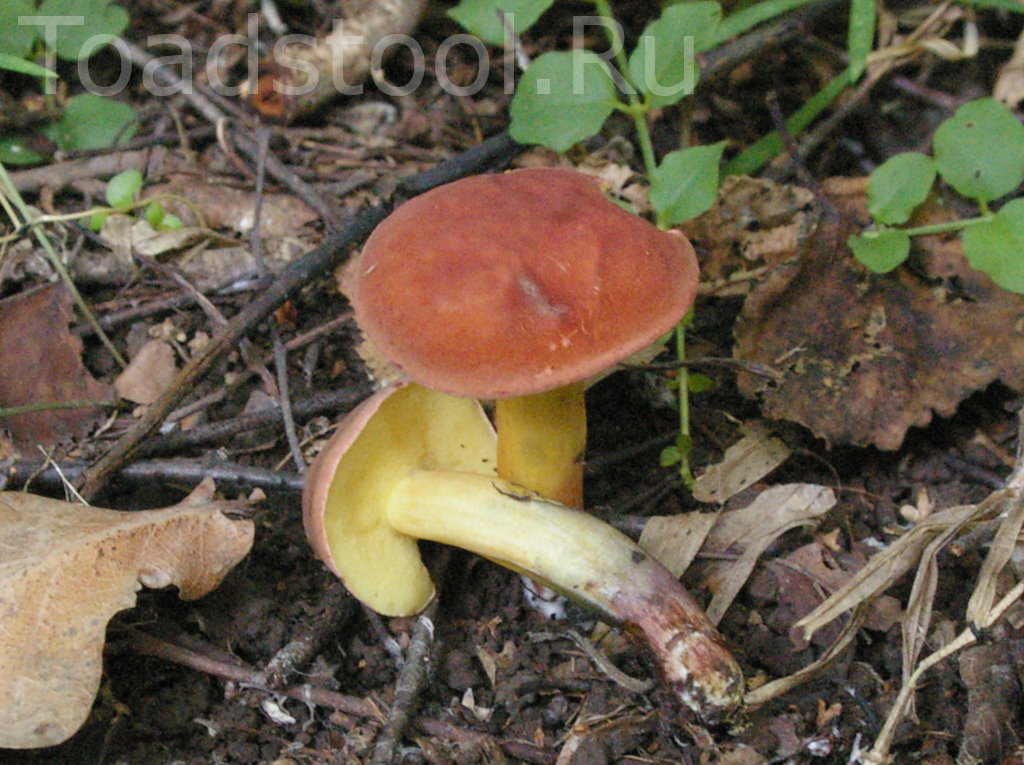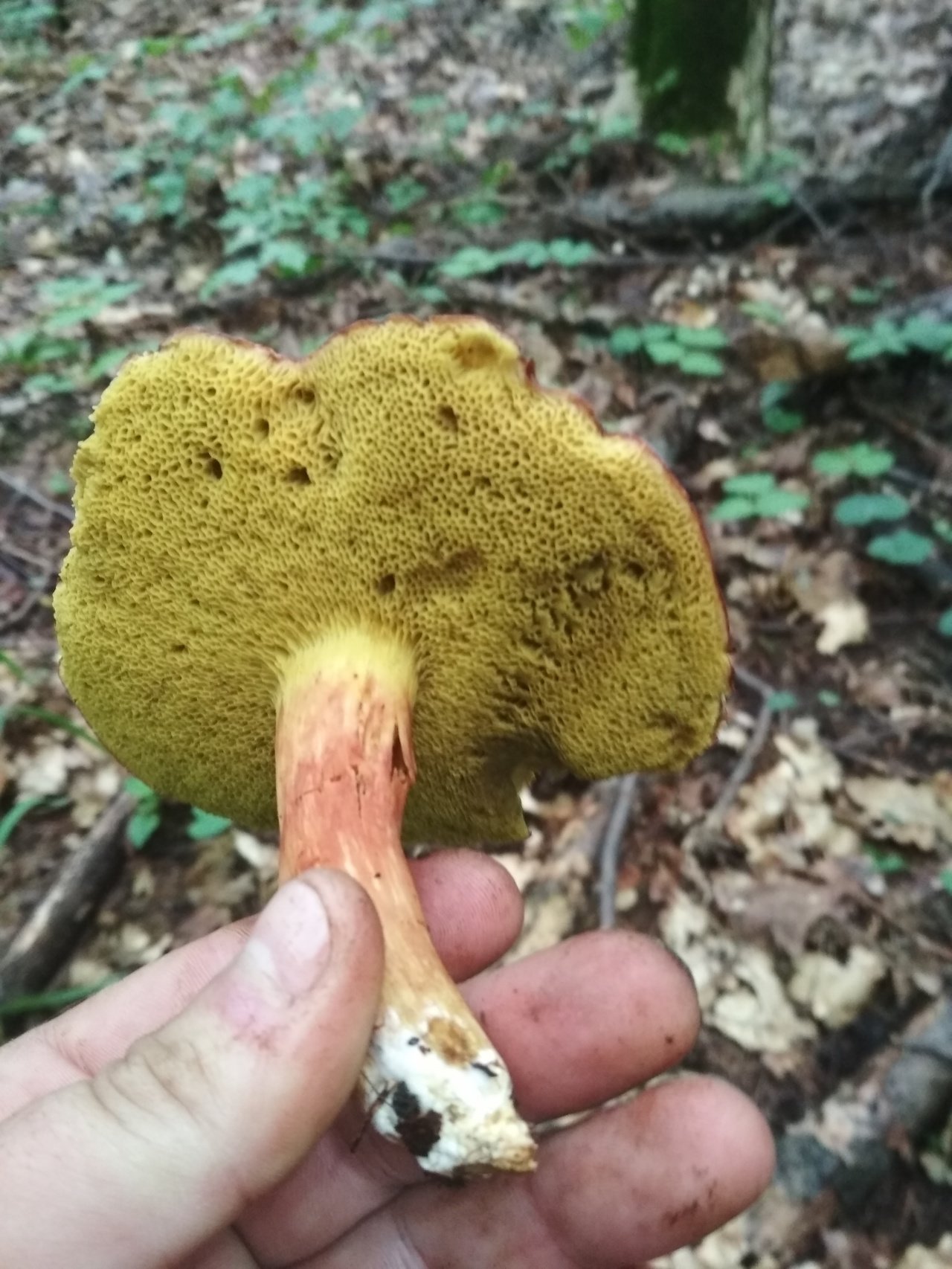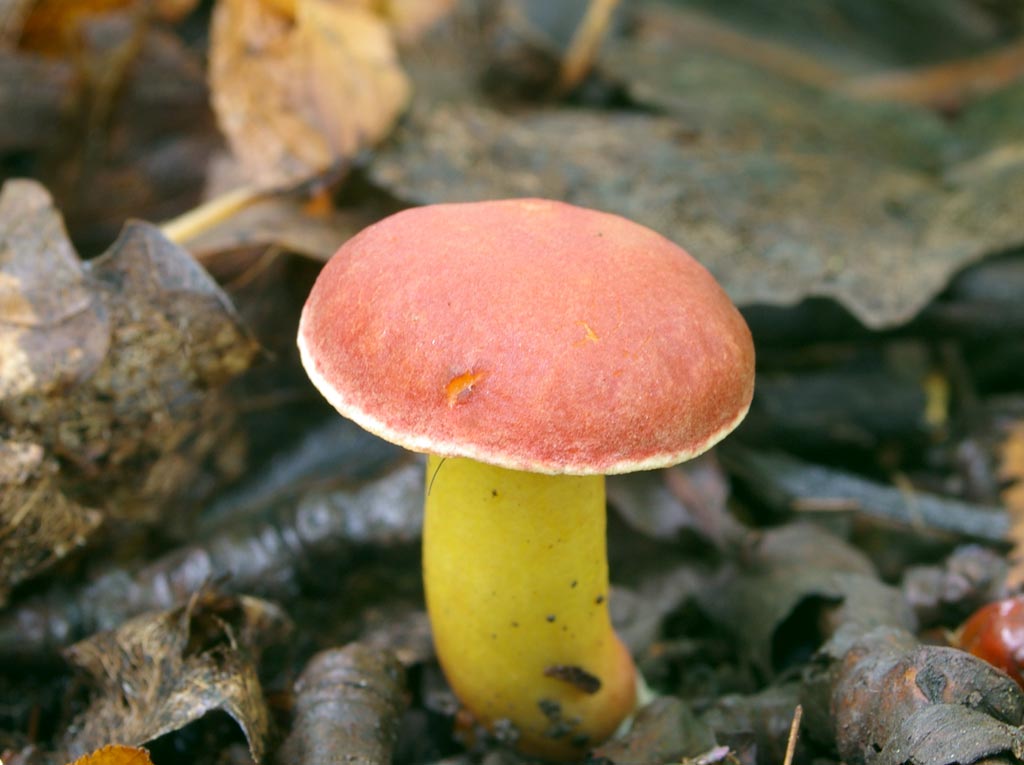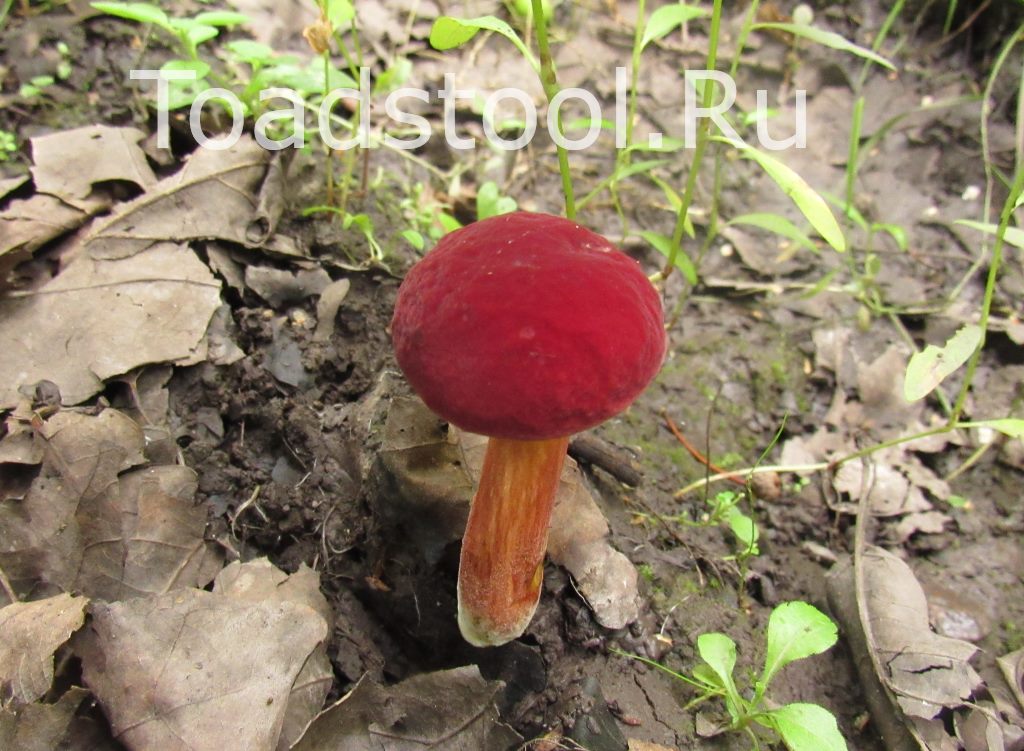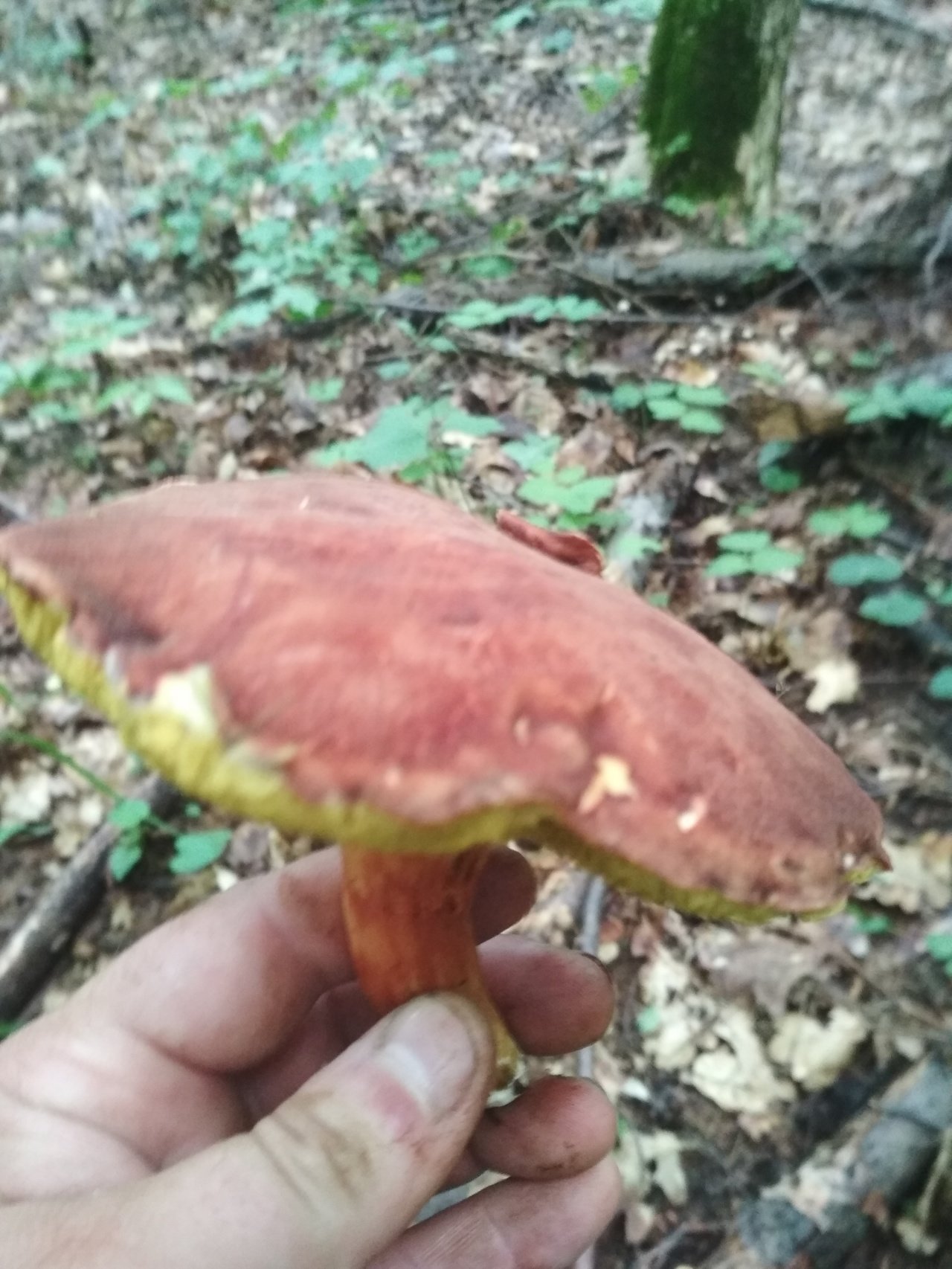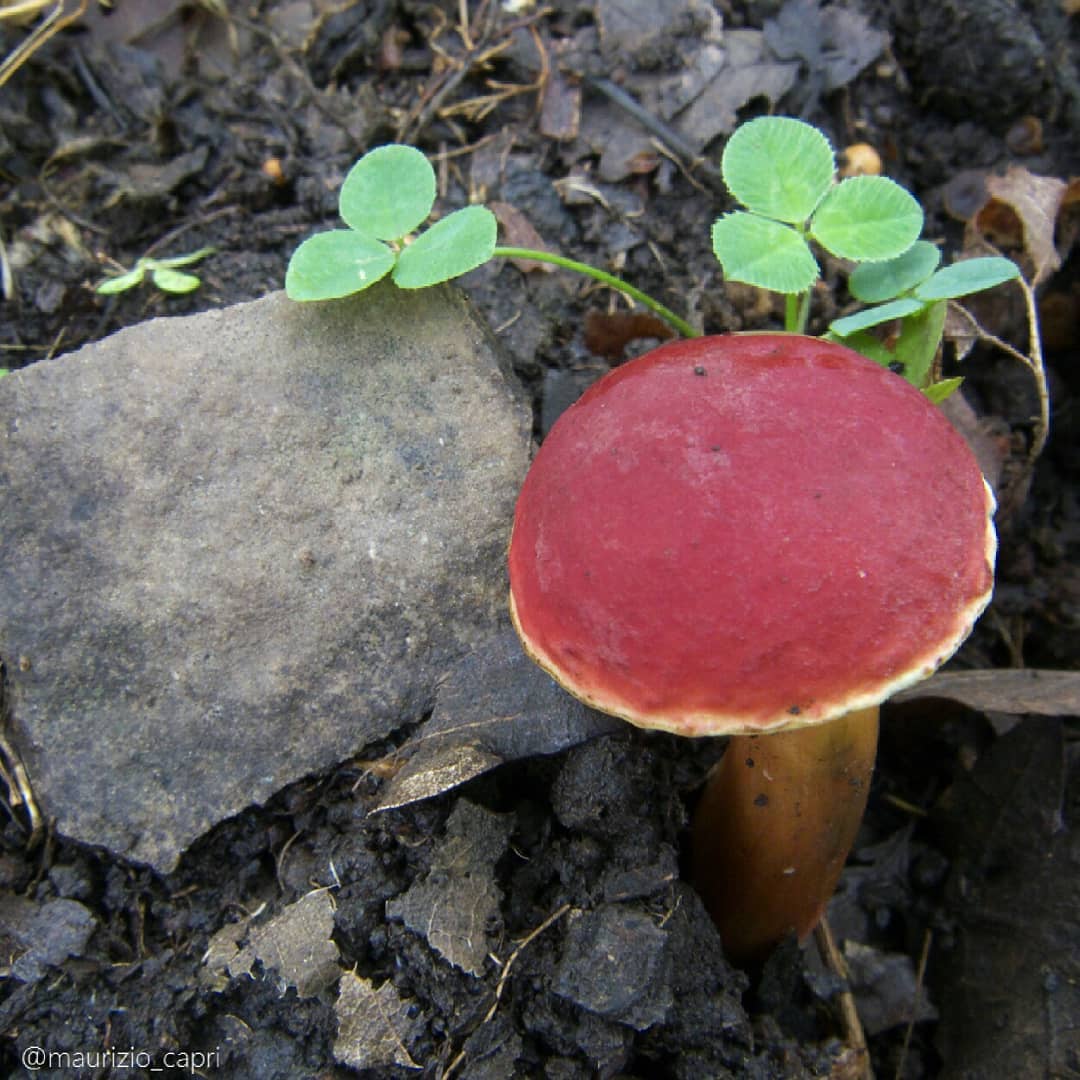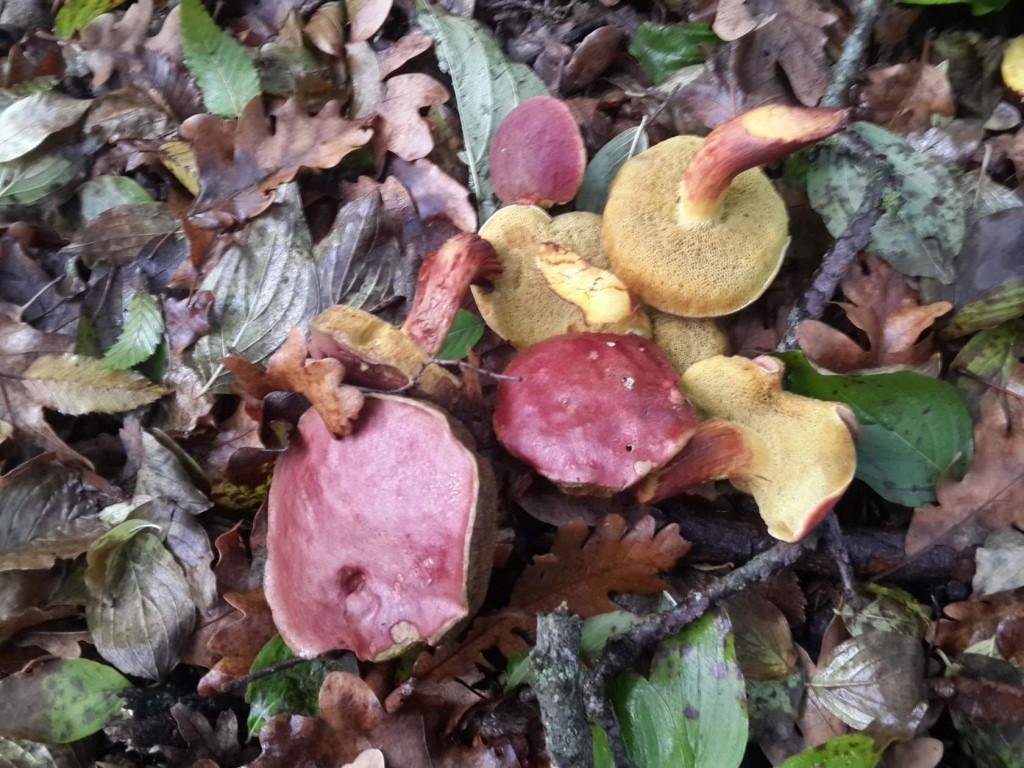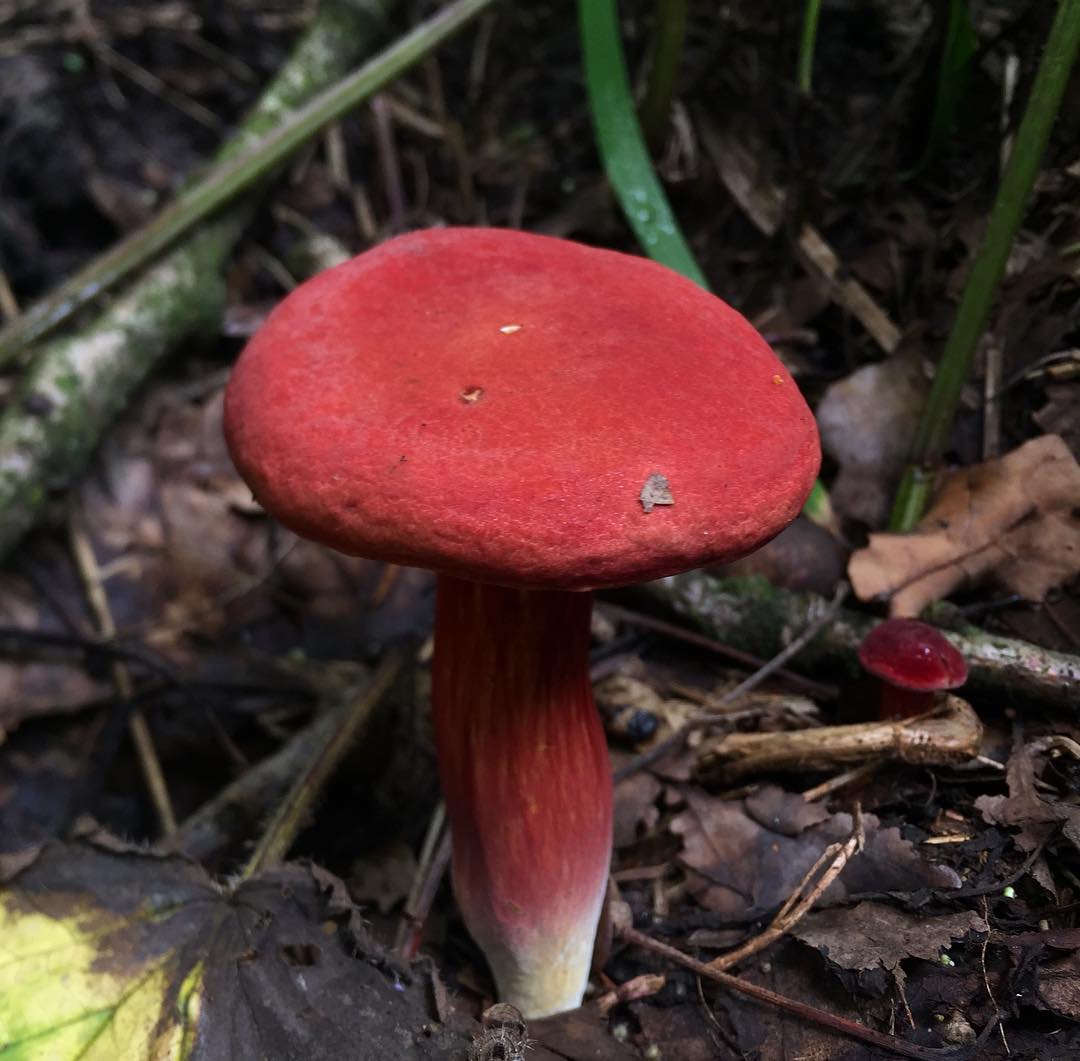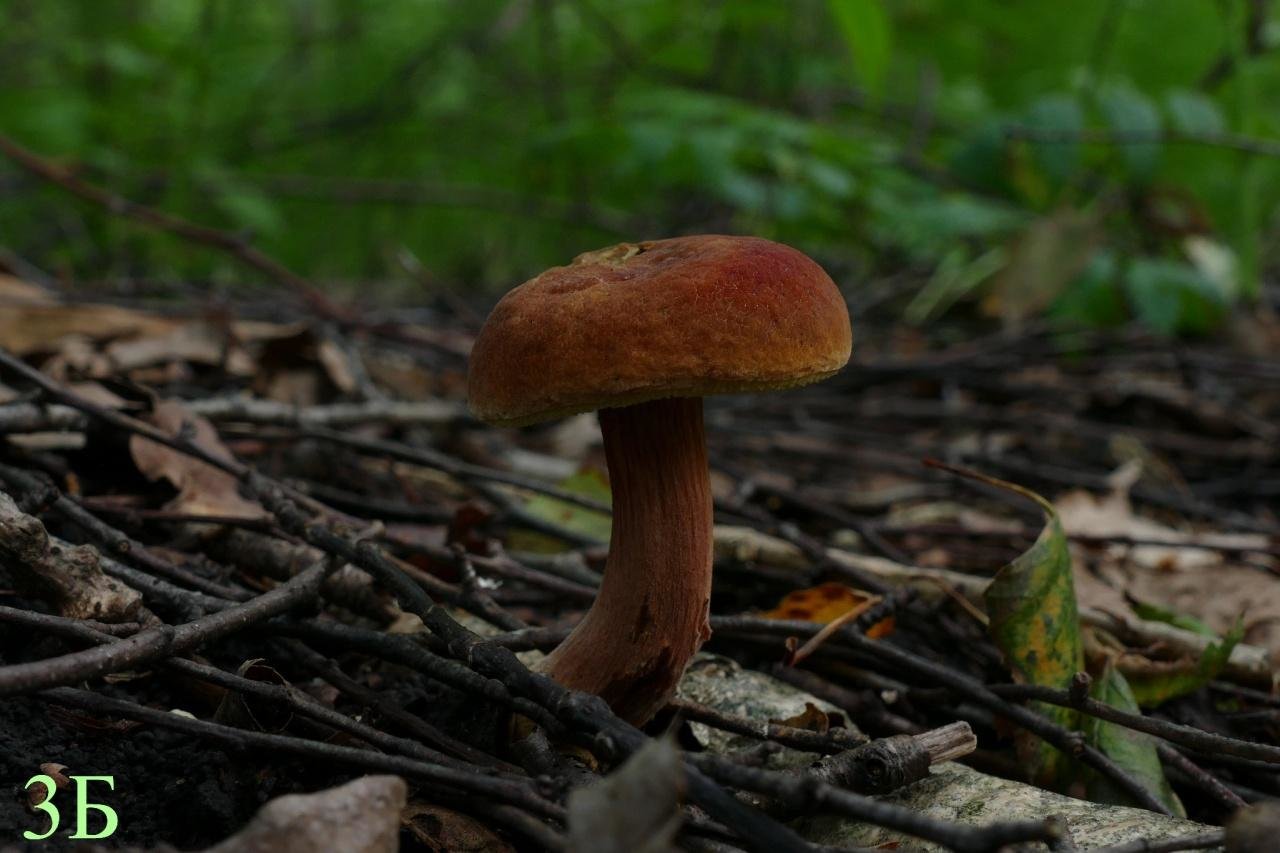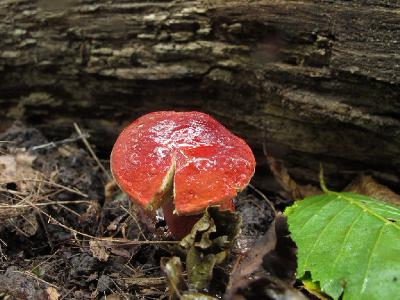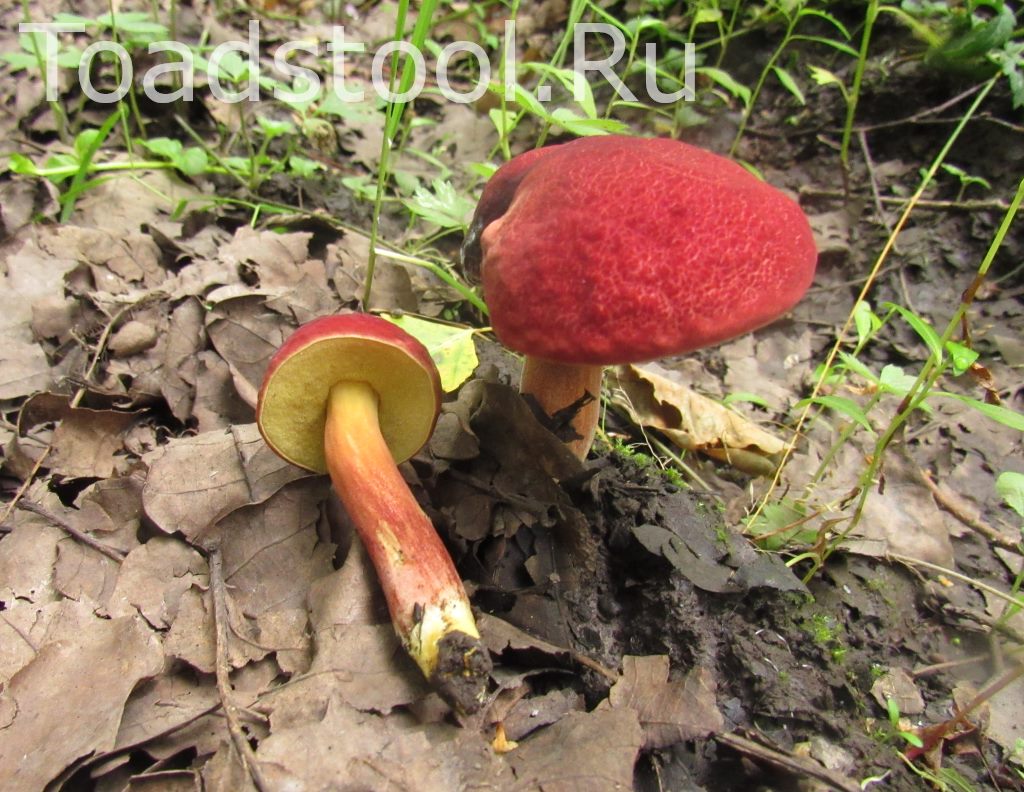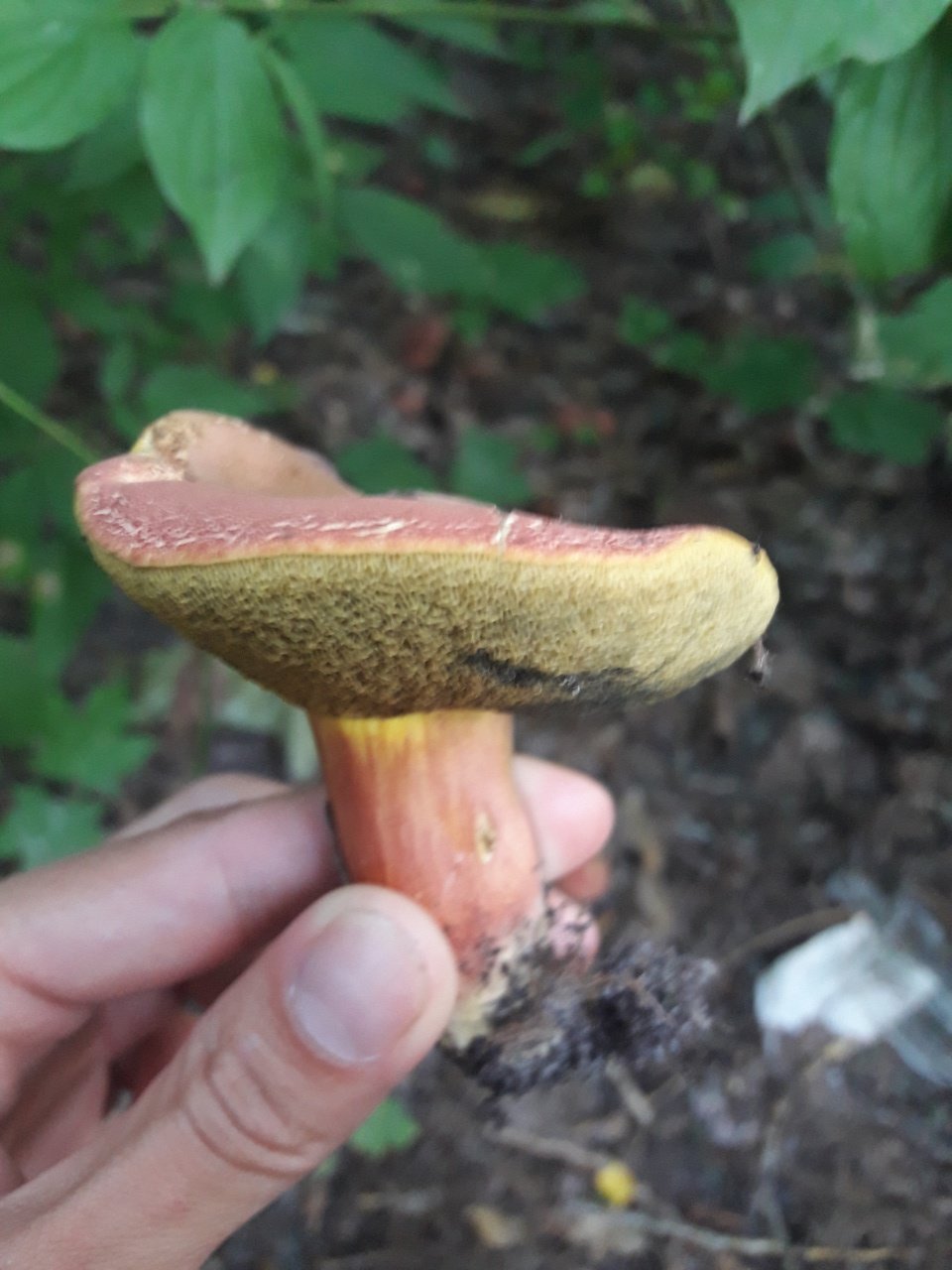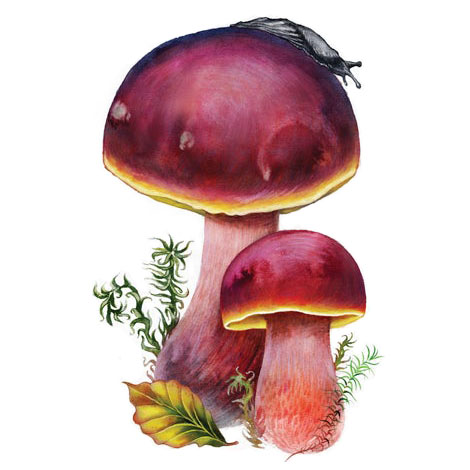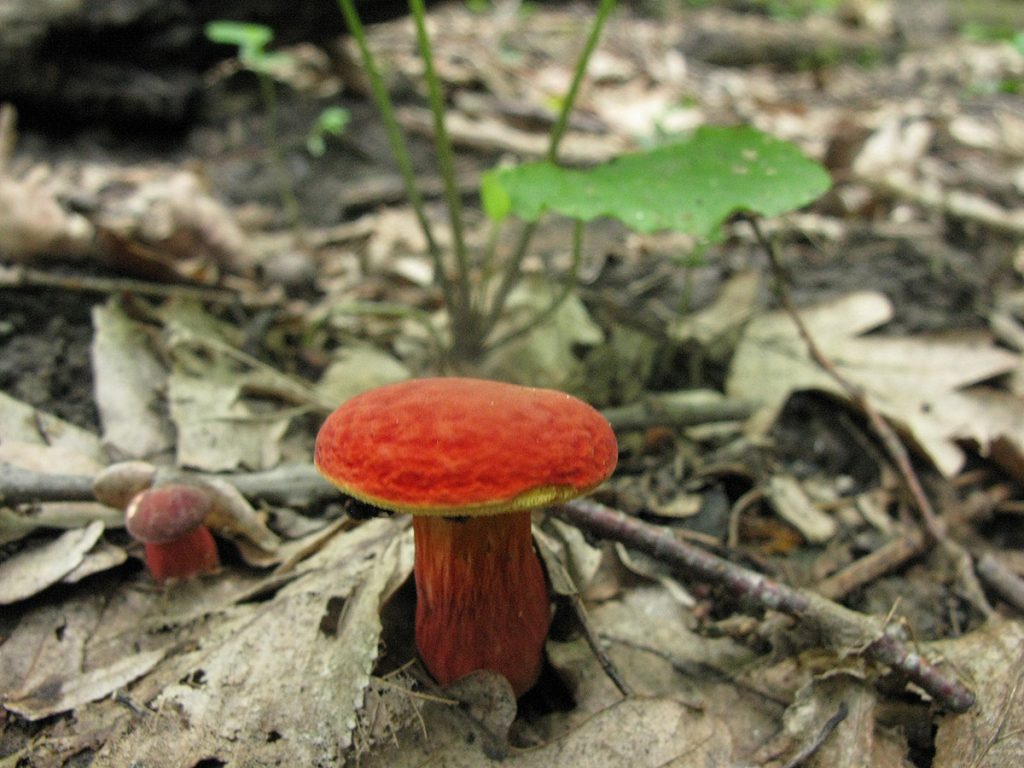Cooking recipes
It is not difficult to cook fissured flywheel, but it is not very popular, because it has a slimy structure in dishes. The most suitable for food are young mushrooms, which can be salted, dried, fried and frozen. They are also used for making soups and stewing, they are good mixed with others.
Primary processing
The main processing of moss flies is to clean them from forest debris, earth and wormholes. It is better to throw away rotten specimens. Next, you should clean it, remove the hard legs from old fruits, then rinse under running water. You can combine these two processes by flooding the mushrooms with water, then gradually clean them.
Cooking
Boil the fissured flywheel in salted water for 30 minutes, then take out the mushrooms, allow the liquid to drain. Now they can be used further or frozen in the chamber for the winter. Salt water during boiling should be to taste.
Pickling
To pickle pasture boletus, you need to take:
- mushrooms - 2 kg;
- salt - 2 tbsp. l .;
- sugar - 1 tbsp. l .;
- vinegar - 3 tbsp. l .;
- garlic - 3 cloves;
- laurel - 3 leaves;
- carnation - 3 buds;
- horseradish and currant leaves - 2 pcs.
The mushrooms are pre-boiled, and at this time the marinade should be prepared:
- Put salt, sugar in a liter of water and bring to a boil.
- Add bay leaves and cloves.
- After a couple of minutes, pour in the vinegar.
- After another minute, add the boiled mushrooms.
- Boil for 15 minutes.
- Now you need to put a sheet of horseradish and currants in each jar, put boiled mushrooms on top and a chive of garlic, pour marinade to the top.
- Close with plastic lids and store on the bottom shelf in the refrigerator.
Freezing
In order to keep the mushrooms in their best shape, and then use them in any dish in winter, they should be frozen. To do this, peeled and boiled cracked mushrooms need to be cooled and laid out in prepared containers or bags. It is most convenient to make portioned blanks, then it will be easy to get the fruits.
Frying
In order to pamper yourself with an unusual and tasty dish, it is best to fry the flywheat and serve with buckwheat. For cooking you will need to take:
- boletus pasture - 1 kg;
- vegetable oil - 3 tbsp. l .;
- onions - 150 g;
- salt and pepper to taste.
Cooking process:
- Pour oil into a frying pan and heat over a fire.
- Add the mushrooms and fry until golden brown.
- Then add the finely chopped onion. It is necessary to remove the dish from the heat when the onion acquires transparency.
Salting
In order to taste the salty cracked flywheel, you need to prepare:
- boiled mushrooms - 1 kg;
- salt - 100 g;
- allspice peas - 6 pcs.;
- laurel - 3 pcs.
The preparation is as follows:
- Flywheels are placed in an enameled dish in layers, sprinkling with salt each time.
- Bay leaf and pepper should also be placed in between the mushrooms.
- Sprinkle the top with salt and cover with a cloth, install the load.
- After a few days, the mushrooms will be covered with brine.
- After a month, ready-made fruits can be tasted.
Mushrooms are salted in a cool, dark place. After they are cooked, further storage takes place in the refrigerator.
Drying
Pestles do not need to be boiled or washed to dry. It is enough just to clean, leave only good whole copies and string them on a thread. Flywheels are hung out on the sunny side in a well-ventilated place.
In order for everything to work out as quickly as possible, it is better to dry the mushrooms in medium-sized pieces, and cut them into equal pieces - this way the drying process occurs more evenly. Store dry forest fruits in a closed container, away from strong odors.
Canning for the winter
In order to prepare mushrooms for the winter, it is enough to marinate them according to the above recipe and sterilize them, then seal them with metal lids and store them in the basement. The mushrooms should be sterilized for at least 30 minutes. All dishes and lids must first be cleaned and heated in boiling water.
Red flywheel (Latin Hortiboletus rubellus)
Name The flywheel is red.Latin name: Hortiboletus rubellus.Other names: Mokhovik blushing, Borovik red, Borovik blushing.Department: Basidiomycota.Class: Agaricomycetes.Order: Boletovye.Family: Boletovye.Genus: Hortiboletus.Edible mushroom.
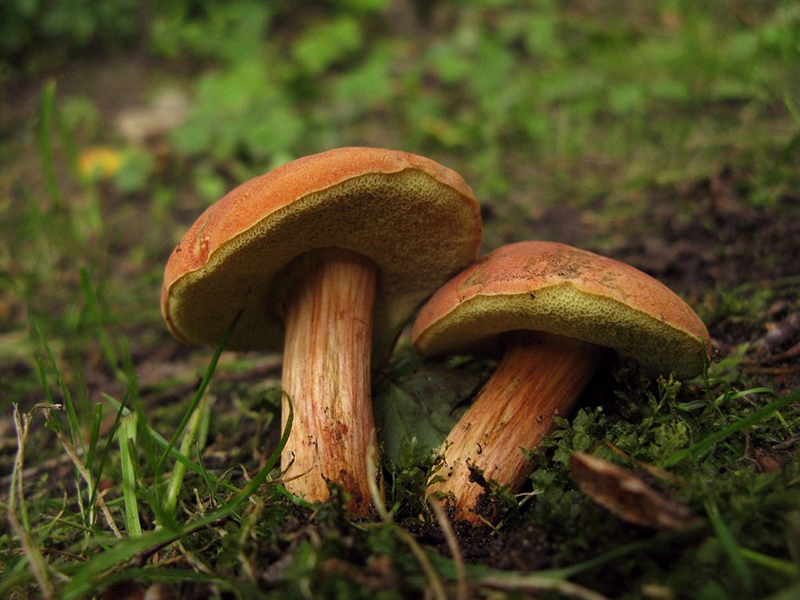 Name The flywheel is red.Latin name: Hortiboletus rubellus.Other names: Mokhovik blushing, Borovik red, Borovik blushing.Department: Basidiomycota.Class: Agaricomycetes.Order: Boletovye.Family: Boletovye.Genus: Hortiboletus.Edible mushroom.
Name The flywheel is red.Latin name: Hortiboletus rubellus.Other names: Mokhovik blushing, Borovik red, Borovik blushing.Department: Basidiomycota.Class: Agaricomycetes.Order: Boletovye.Family: Boletovye.Genus: Hortiboletus.Edible mushroom.
Leg
35–90 mm in height, 5–15 mm in thickness, cylindrical, not hollow, often curved, in the upper part it has a light yellow color, below the color varies from light red to scarlet. At the base, the stem is often narrower and has a yellowish mycelium.
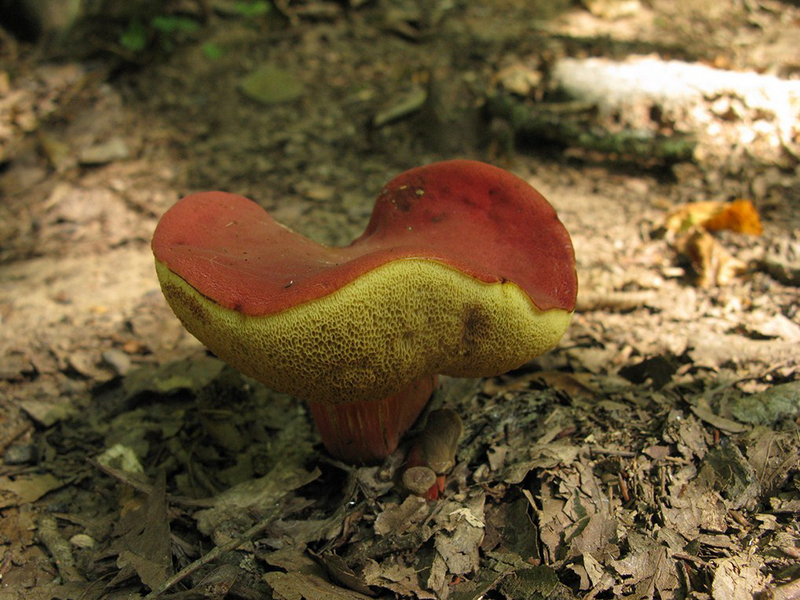
Hat
20–70 mm in diameter, in young fruiting bodies it is convex, bright red in color. As the fungus grows, it becomes more straightened (cushion), the color acquires darker tones with an olive or brown tint. The skin is felted at first, smooth; in old mushrooms, it can crack at low humidity. It should be noted that the edge of the cap is often yellowish in color.
Hymenophore
Tubular, notched, tubules 15–20 mm long, yellow; as the fungus grows, they become olive yellow. The pores are lemon yellow, small, rounded, turn blue when pressed.
Dense, yellow, turns blue on the cut, the smell is pleasant, mushroom, the taste is not pronounced.
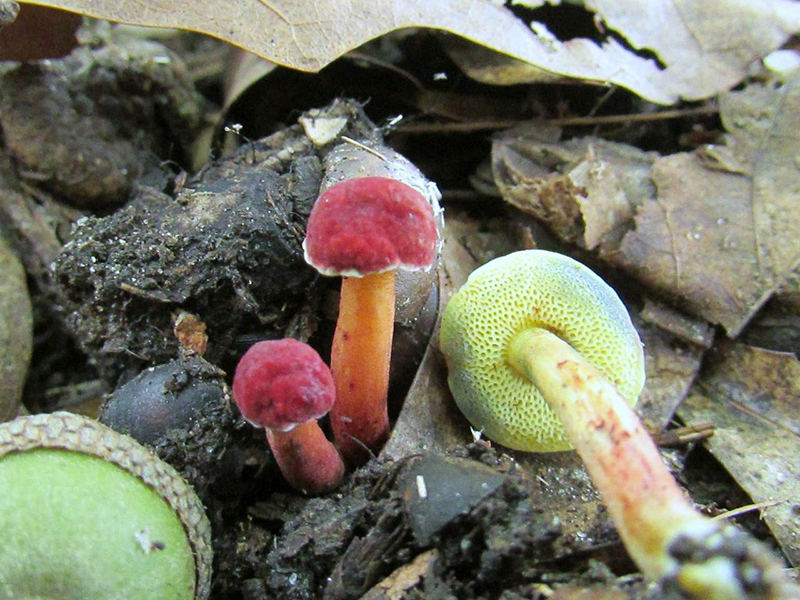
Habitat
It grows on the ground singly or in small groups, among mosses and rare grass, very often forms mycorrhiza with oak.
Similarity
Red flywheel (Hortiboletus rubellus) has similarities with some representatives of the Boletov family, but due to its bright colors it is almost impossible to confuse it with other species growing on the territory of the CIS.
|
December |
January |
February |
|
March |
April |
May |
|
June |
July |
August |
|
September |
October |
November |
Larch flywheel (Psiloboletinus lariceti)
Synonyms:
- Boletinus lariceti
- Larch boletin
Psiloboletinus is a genus of fungi of the Suillaceae family. It is a monotypic genus containing one species, Psiloboletinus lariceti. The species was first described by the mycologist Rolf Singer in 1938 as Phylloporus. Alexander H. Smith disagreed with Singer's general concept, concluding: “Regardless of which arrangement of the type species Psiloboletinus is ultimately made, it is clear that there are no clearly distinguishable characters by which the genus could be recognized. based on Singer's descriptions ”.
"Larch" - from the word "larch" (a genus of woody plants of the pine family, one of the most common species of conifers), and not from the word "deciduous" (Deciduous forest - a forest consisting of deciduous trees and shrubs).
Description
Hat: 8-16 cm in diameter; under favorable conditions, specimens with caps of about 20 centimeters are possible. In youth it is convex, with a strongly tucked inward edge, then flat-convex; in very adult mushrooms, the edge of the cap is not tucked up, it may be slightly wavy or lobed. Dry, felted or tomentose-scaly, velvety to the touch. Brownish, ocher-brown, dirty brown. Flesh in the cap: dense (not loose), soft, up to 3-4 cm thick. Light yellowish, light buffy, very pale, almost white. Turns blue at a break or cut.
Hymenophore: tubular. The tubules are large, wide, with thickened side walls, and therefore visually form a semblance of plates.They run down strongly on the leg, where they become elongated, which is why their visual resemblance to the plates increases. The hymenophore is yellow, light in youth, then yellowish-brownish. When damaged, even minor, it turns blue, then turns brown.
Spores: 10-12X4 microns, cylindrical, fusiform, brown-yellow with drops.
Leg: 6-9 centimeters high and 2-4 cm thick, central, can be thickened at the bottom or in the middle, velvety. In the upper part it is light, in the color of the hymenophore, yellowish-brownish, below it is darker: brownish, brownish, dark brown. Turns blue when pressed. Whole, sometimes with a cavity. The flesh of the leg: dense, brownish, blue.
Ring, bedspread, volva: none.
Taste and smell: mild mushroom.
Ecology
It grows only in the presence of larch: in larch forests and mixed forests with the presence of birch, aspen, under larch.
Season and distribution
The peak of fruiting occurs in August-September. It is well known only on the territory of Russia, found in Western and Eastern Siberia, Amur region, Khabarovsk Territory, in the Far East, especially often and abundantly bears fruit on Sakhalin, where it is called "Larch moss" or simply "moss".
Edibility
The mushroom is edible, there is no data on poisoning. It is used for making soups, salads, main courses. Suitable for pickling.
Similar species
A slender pig in some growth stages can be mistaken for a larch flywheel. You should carefully look at the hymenophore: in the pig it is lamellar, in young specimens the plates are wavy, so that at a cursory glance they can be mistaken for large tubes
An important difference: the pig does not turn blue, but turns brown when tissue is damaged
Gyrodons are quite similar to Psiloboletinus lariceti, you should pay attention to the ecology (type of forest). Goat, it differs in the color of the flesh in the damaged areas, its flesh does not turn blue, but turns red
The goat, differs in the color of the flesh in the damaged areas, its flesh does not turn blue, but turns red.
Healing properties
Purposeful studies were carried out, there are works on the thrombolytic properties of enzymes of basidal fungi (Botanical Institute named after V. L. Komarov, Russian Academy of Sciences, St. Petersburg, Russia), where there is a high fibrinolytic activity of enzymes isolated from Psiloboletinus lariceti. However, it is too early to talk about widespread use in pharmacology.
Note: The photographs from the questions in "Recognition" are used as illustrations in this article. If you have good photos of this mushroom, please share.
How to collect and prepare flywheels?
Flywheels are harvested from mid-summer to mid-autumn. When collecting, you need to cut off only the fruit body, leaving the mycelium in the ground, so that the next year you can get a crop of moss. The collected mushrooms are sorted out, discarding the spoiled and wormy ones. Then they are thoroughly washed and various dishes are prepared from them. If there are a lot of mushrooms, you can store them in the refrigerator for some time, but not more than 2-3 days. It is better to freeze or dry the excess immediately. Before freezing, the mushrooms should be boiled in salted water for a while.
Flywheels can be pickled and salted. They are good because their caps do not need to be peeled off: it is enough to rinse and scrape the damaged areas with a knife. Marinades are prepared on the basis of vinegar with the addition of various ingredients. Boil the mushrooms before pickling. Mushrooms are salted hot and cold. In the first case, garlic is never added and boiled for a short time so that the mushrooms do not creep. Otherwise, the methods of salting mushrooms do not differ from other mushrooms.
Dishes made from mushrooms are very varied. It can be salads, soups, main courses, aspic. Mushrooms can be added to pizza, vegetable caviar, and pie filling. Dried mushrooms are used to add to various sauces. Cooked in any way, these mushrooms taste great.
Photo by: George Chernilevsky, public domain
Description and photo
Due to its incredible taste, this forest gift is very popular among mushroom pickers. Finding a basket of flywheels is a real success. But how to distinguish it from other representatives of the forest kingdom? Of course, for this you need to know what this mushroom looks like.
From Latin - xerocomus subtomentosus.
Hat
The cap of the flywheel is very dense and has a diameter of 4 to 12 cm. In many respects, it depends on the conditions in which the mushroom grows and what its age is. If we talk about color, then it can be called green at a stretch. It usually has a greenish gray or olive surface. Sometimes it is even brown, but this applies to old mushrooms. The shape is slightly convex. If you touch the mushroom from above, then it has a very velvety pleasant hat. However, every touch leaves a small mark and imprint on it.
On the cut, the pulp is white and does not lose its hue when interacting with oxygen. Smells very tasty, also dense. There are small white tubes under the cap, from where the spores fall out. The tubular layer is yellow, has a greenish or olive base. If you press hard, then this mushroom will begin to turn blue.
Leg
The stem of the mushroom, on the other hand, has the shape of a cylinder. Stable, and its pulp is no less tasty than the cap. White when cut, turns blue when pressed.
Despite the fact that this fungus is edible, it still sometimes becomes covered with mold, which can be dangerous to humans. However, it can be cleaned off.
Why does the flywheel turn blue? This very much worries the people who collect it. Sometimes, seeing that blue is forming under the imprint, mushroom pickers refuse to collect. In fact, the pulp turns blue due to a special process. However, this is not at all a sign that the mushroom is poisonous. It contains substances that, if damaged, begin to react with oxygen. As a result, the oxidation process begins. It is because of him that the surface darkens. A dark film is formed during oxidation
Characteristic features and types of false flywheels
Due to the long fertile period (from June to November) and the variety of varieties, the mushroom often becomes an object of interest for mushroom pickers. It has an affinity with boletus, is valued for its expressive taste, and is easy to digest. Grows in mixed coniferous forests, literally forming a symbiosis with trees.

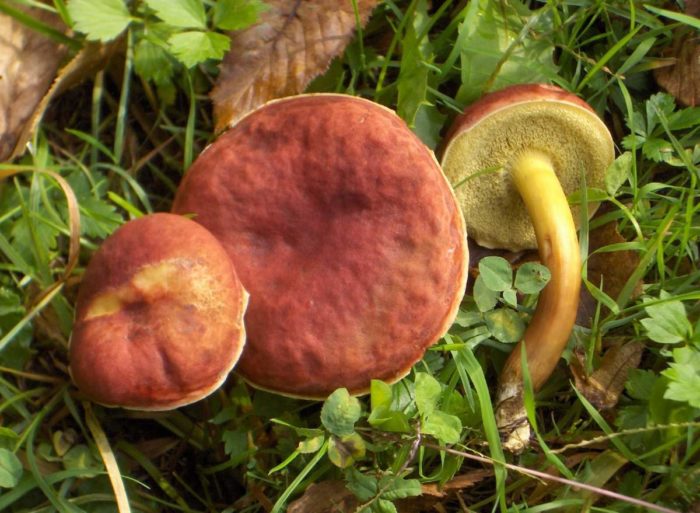
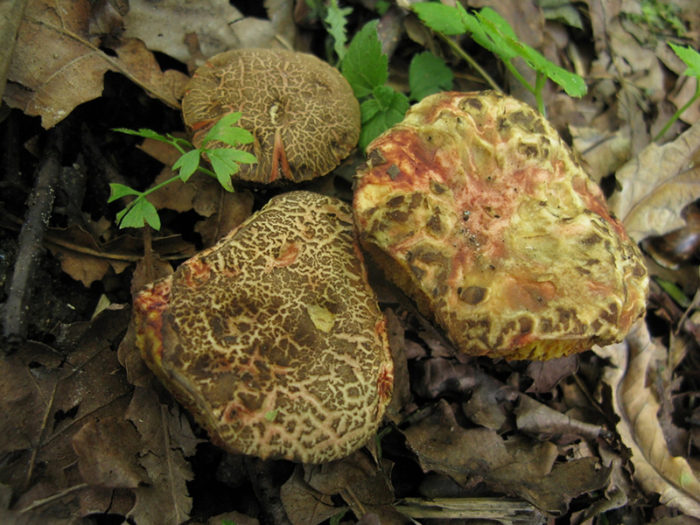
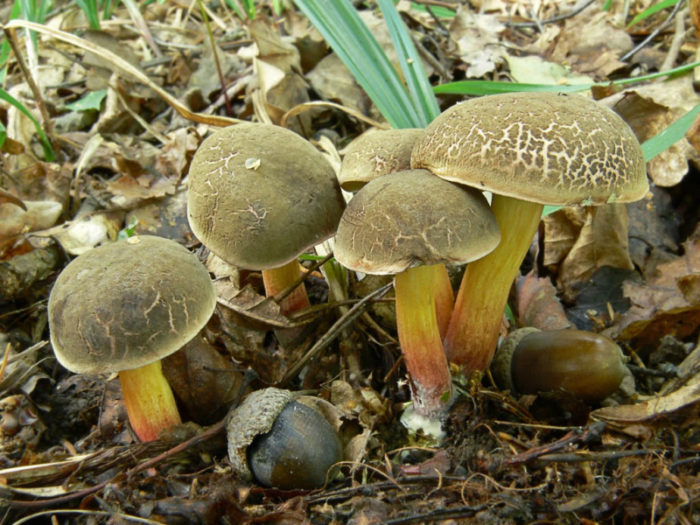


The most striking taste qualities are possessed by red, Polish and variegated mushrooms. Because of this, it is worth knowing that there are representatives of this species, which are considered conditionally edible. These varieties include chestnut, pepper, bilious and parasitic flywheels. Distinctive features of the "wrong" mushroom may be the place of growth, its size, and most importantly - taste.
In order not to be deceived and not to bring home a false flywheel, the mushroom must be carefully studied from the photo and description and understand the visual differences, such as color, size and shape.
Pepper
The harvest time for this variety is from mid-summer to mid-autumn. Pepper mushroom is characterized by the fact that only 2-3 pieces grow on one mycelium. The taste is directly related to the name - burning, spicy.
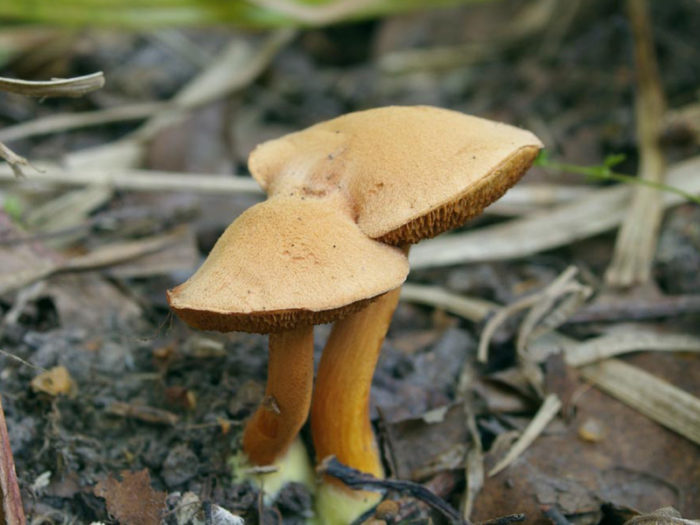
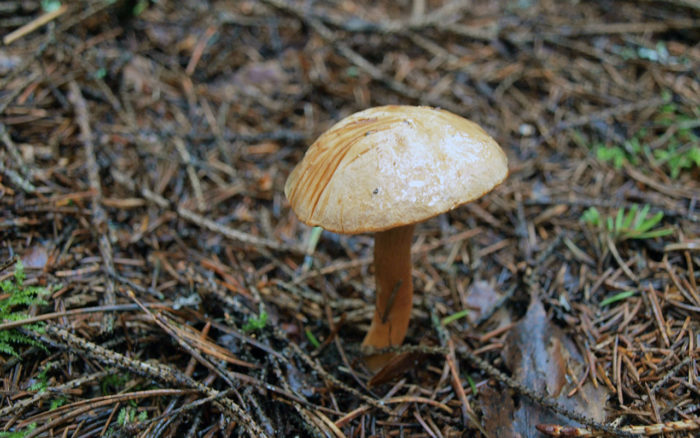
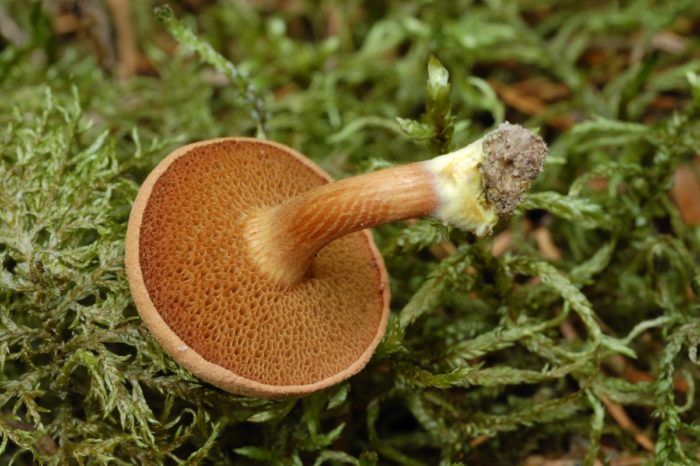
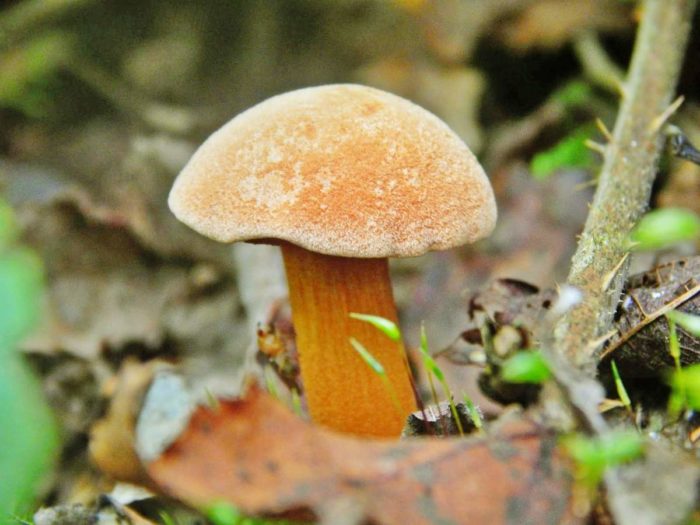
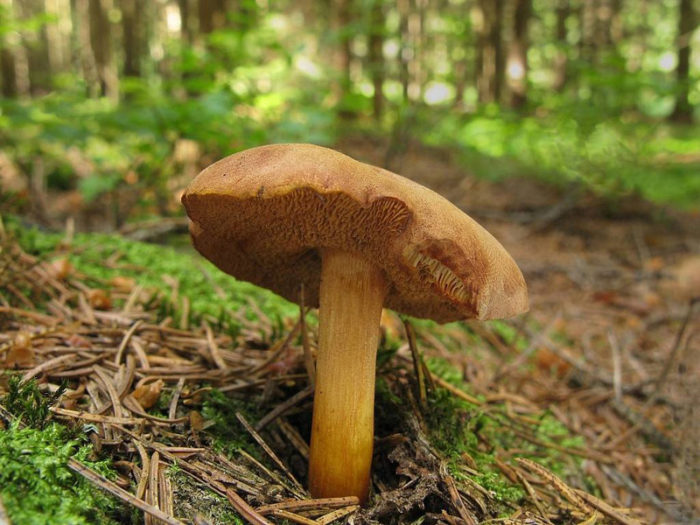

The diameter of the cap varies from 2 to 8 cm. In the early stages, the shape is convex-rounded, evens out as it grows. Has a soft top layer, can glare in the sun. The hat is light brown, it can have different shades of red. The structure of the pulp is loose, fragile. The color is yellow, with a reddish tint, the red color is enhanced on the cut.
The stem of the pepper mushroom is rather thin, reaching 2 cm in thickness and up to 8 cm in height. Cylindrical, has a smooth surface, the same color as the cap itself, or a shade lighter. The tubular layer, which has pores of various sizes, adheres rather tightly to the body of the leg. The color of the porous layer is brown, sometimes with a red tint. If you squeeze it, then a pronounced brown tint will appear.
Chestnut
The yield period is from July to November.It grows in not very large groups, sometimes one by one. This species is adjacent to such trees as beech, oak, chestnut. This representative is often confused with the Polish one. During heat treatment, it acquires strong bitterness, but absolutely loses it during drying. The chestnut mushroom has a weak smell.
It has a hat with a diameter of 5-8 cm. Its shape is slightly convex, less often it is flat. The color is often chestnut, but it can also be brown, brown, with a reddish tint. The hat is dry to the touch; in dry times, cracks may appear on it due to lack of moisture. The flesh is white, quite firm in the early stages of ripening, becomes firm over time. It does not darken on the cut; when pressed, brown spots appear.
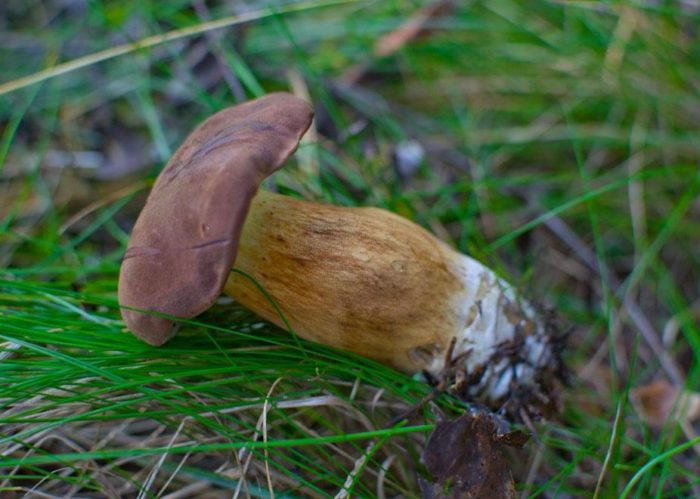
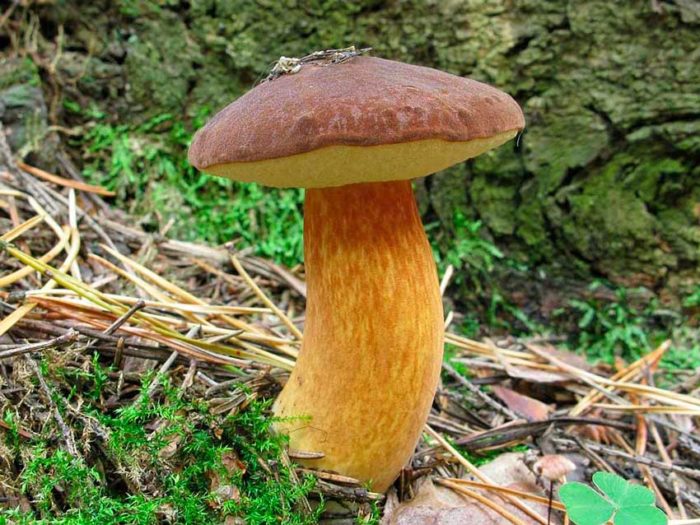
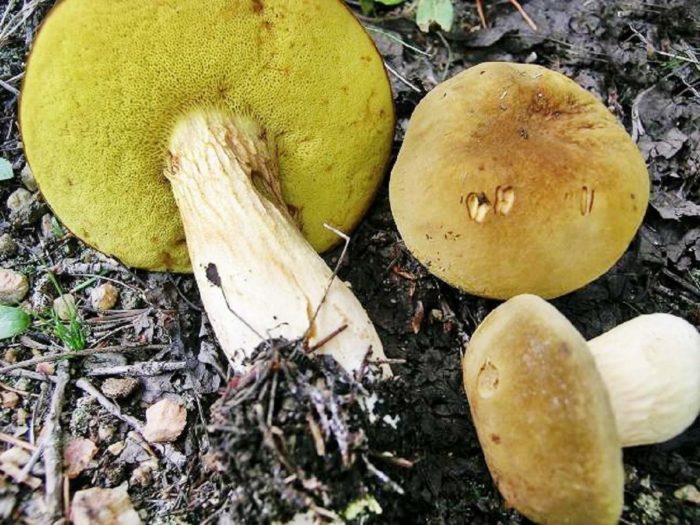
The leg is in the form of a cylinder, the same color as the hat, or a shade darker. Dimensions - length up to 6 cm, width no more than 3 cm. The legs of young mushrooms have a filling similar to cotton wool, while adults are hollow inside. The initially tubular white or light cream colored layer turns yellow as it ages.
Parasitic flywheel
It grows in the summer-autumn period. Based on the name, it can be understood that this species settles on the bodies of other mushrooms. Grows in dry places, on sandy soils. Visually similar to a green flywheel. It has an unpleasant taste, but it is practically odorless.
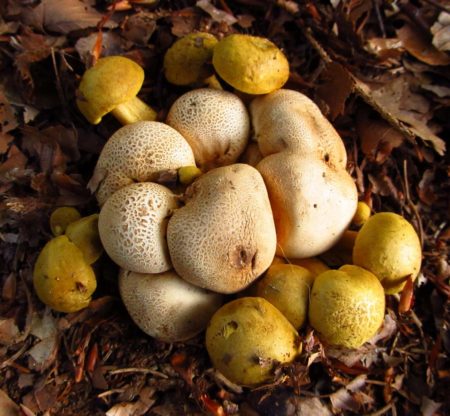
The hat is convex, 2-7 cm in diameter, the edges are wrapped inward. The colors range from lemon yellow to brown rusty. The surface is velvety to the touch and slightly oily. The pulp is light yellow in color, dense, does not change color at the break.
The parasitic fungus has a very thin stem - maximum 1.5 cm. The height usually does not exceed 6 cm. The shape is cylindrical, the structure is fibrous, and solid. Coloring - olive, yellow. The pores of the tubular layer are colored to match the cap, wide, with ribbed edges.
Bilious
Fruiting from June to October in deciduous and coniferous forests. It grows both singly and in groups. Has a characteristic bitter taste that causes a burning sensation.
The hat can be 4-15 cm in diameter, has shades from yellow-brown to light brown, more often of a light color. The shape is hemispherical in young representatives and more rounded, outstretched in mature ones. The pulp at the early stages of ripening is white, with age it acquires a pinkish tint. The structure is fibrous, or odorless, or with characteristic mushroom notes.
The shape of the leg is often cylindrical, swollen from below. Height 3-13 cm, width 2-3 cm. When ripe, the leg is covered with a dense mesh of small fibers that have a brown or gray color. A distinctive feature of this species is that when it breaks, it immediately darkens, acquires a brown color. The gall fungus is rarely affected by insects and worms.


